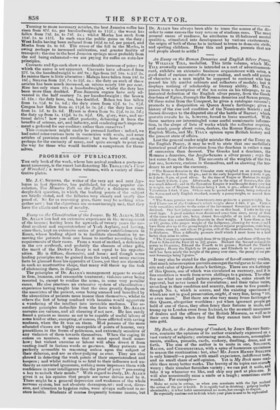An Essay on the Roman Denarius and English Silver Penny
by %Visual' TILI„ medallist. This little volume, which Mr. TILL avowedly announces is intended as a sort of advertisement card, exhibits an extensive business acquaintance with coins, a good deal of curious out-of-the-way reading, and such odd points of character as a man might be supposed to contract who has passed his life amidst cabinets and collectors of medals ; but it displays nothing of scholarship or literary ability. Mr. TILL passes from a description of the ten coins on his titlepage, to an historical deduction of the English silver penny, from the Greek drachma of Egina, through the Roman denarius and Saxon penny, Of these coins from the Conquest, he gives a catalogue raisonne; proceeds to a disquisition on Queen Anne's farthings; gives a history of the rise and condition of the Numismatic Society ; and thence diverges to the disputed site of the battle of Barnet; which queestio vexata he is, however, forced to leave unsettled. With these matters are intermingled some useful numismatic informas tion, in the shape of lists of works which the collector requires, and much gossip about coins, dealers, the Roman Emperors, the English Mints, and Mr. TILL'S opinion upon British history and the present state of affairs. Lest the general reader might mistake the scope of the Essay on the English Penny, it may be well to state that our medallist's historical proof of its derivation from the drachma is rather a case of succession than descent. The Greeks had a drachma, the Romans a denarius, the Anglo-Saxons a silver penny ; ergo the last came from the first. The accounts of the weights of the two last are, however, curious in themselves, and as showing the tendency to act upon the currency.
"The Roman &florins in the Consular state weighed on an average from 2 ilwts. Mgrs. to 2 dwts. 13 grs., and in the early Imperial from 2 dots. G grs. to 2 dwts. 9 grs. of good silver. la the time of Trojan or Hadrian its weight was barely 2 'Bets. 2 grs. Afterwards, and in the reign of Seven's, this coin was much debased ; and in the Byzantine Empire it was brought down very low in weight, one of Magnus 'Maximus being 1 dwt. 6 grs., others of Valens and Valentinian 1 lot. 8 grs. Others may be quoted still lower, being reduced to the SAN011and early English standard, namely a pennyweight, so named from the coin:
" The Saxon pennies were from twenty-two grains to a pennyweight. In. deed 1 have one of the Confessor's which weighs above 1 tlwt. 1 gr. There is truly something relative to the coins of the last-named Sovereign not to be understood. Our best judges cannot satisfy me on this head. I refer to his very small type. A great number were discovered sonic time since, ninny of them of the same type and size, being almost five.eightlis of an inch in diameter, while there was a considerable diversity in their weight. I have them as law as 11)4 grains, (the proper weight of the halfpenny, allowing for wear ;) and I have them also up to the pennyweight in almost regular progression, some being 13 grains, sonic 13, and others 18 grains, still of the same diameter, but varying in thickness. Thus a difficulty presents itself which I must leave to a head better than mine to solve.
"The Conqueror's pennies weigh from 20 to 22 grains, and those of Henry the First to Edward the First 21 to 226 grains. Richard the Second reduced the penny to 18 grain,; Edward the Fourth to 15 grains ; Richard the Third to 12 grains ; Henry the Eighth to 10 grains; and Elizabeth to 8 grains ; and such has been nearly the weight of the penny ever since, the penny of our pre. sent Sovereign being 7 grains."
It may also be stated for the guidance of far-off country readers, that much misconception prevails amongst the vulgar as to the scarcity and value of Queen Anne's farthings. There are six farthings of this Queen, one of which was circulated as currency, and if in fine condition is worth from seven shillings to a guinea. The other five are what are called pattern pieces,-that is, coins struck for approval, but never issued for circulation ; and their value varies, according to their condition and scarcity, from one to five pounds; though No. 4, which is scarce, and the existing specimens of which are not in good preservation, might, if very fine, bring "10/. or even more." But there are also very many brass farthings of this Queen, altogether worthless : yet when ignorant people get hold of one of these, they often fancy their fortune is made, and tramp up to London even from Ireland, to the no small annoyance of dealers and the officers of the British Museum, as well as to their own dismay when they find they cannot turn their brass into gold.


























 Previous page
Previous page